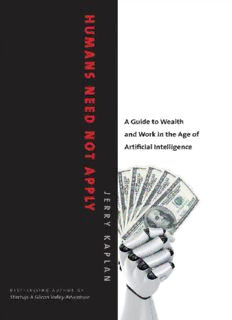
Humans Need Not Apply: A Guide to Wealth and Work in the Age of Artificial Intelligence PDF
Preview Humans Need Not Apply: A Guide to Wealth and Work in the Age of Artificial Intelligence
H U M A N S N E E D N O T A P P L Y n o d n o l d n a n e v a h w e n H U M A N S N E A Guide to Wealth and Work in E D the Age of Artificial Intelligence N O T j e A r P r P y L Y k a p l a n Published with assistance from the foundation established in mem- ory of Calvin Chapin of the Class of 1788, Yale College. Copyright © 2015 by Jerry Kaplan. All rights reserved. This book may not be reproduced, in whole or in part, including il- lustrations, in any form (beyond that copying permitted by Sections 107 and 108 of the U.S. Copyright Law and except by reviewers for the public press), without written permission from the publishers. Yale University Press books may be purchased in quantity for educa- tional, business, or promotional use. For information, please e-mail [email protected] (U.S. office) or [email protected] (U.K. office). Designed by Sonia Shannon. Set in The Sans type by Integrated Publishing Solutions, Grand Rapids, Michigan. Printed in the United States of America. Library of Congress Control Number: 2015930743 ISBN 978-0-300-21355-3 (cloth : alk. paper) A catalogue record for this book is available from the British Library. This paper meets the requirements of ANSI/NISO Z39.48–1992 (Per- manence of Paper). 10 9 8 7 6 5 4 3 2 1 For Camryn Paige Kaplan Turn your dreams into words and make them true. This page intentionally left blank s t n e t n o C Preface ix Introduction: Welcome to the Future, 1 1. Teaching Computers to Fish, 17 2. Teaching Robots to Heel, 33 3. Robotic Pickpockets, 49 4. The Gods Are Angry, 59 5. Officer, Arrest That Robot, 77 6. America, Land of the Free Shipping, 93 7. America, Home of the Brave Pharaohs, 107 8. Take This Job and Automate It, 129 9. The Fix Is In, 159 Outroduction: Welcome to Your Children’s Future, 189 Acknowledgments, 209 Notes, 211 Index, 229 i i i v S T N E T N O C e c a f e r P I’m an optimist. Not by nature, but by U.S. government design. After Russia humiliated the United States with the 1957 launch of Sputnik, the first space satellite, the government decided that science education should be a national priority. The cold war was in full swing, and Senator John F. Kennedy made closing the “missile gap” a centerpiece of his presidential campaign. Ceding leadership in this critical emerging arena was unthinkable. Young boys like me (but tragically, not many girls) were fed a steady diet of utopian imagery extolling technological innovation as the path to eternal peace and prosperity, not to mention a way to beat them clever Russkies. Dog-eared copies of Amazing Stories and Fantastic Adventures illustrated how spaceships and ray guns would help you save the world and get the girl. When I moved to New York at the age of ten, the city seemed the Land of Oz to me, and the 1964 World’s Fair was the Emerald City. For less than the two dimes tucked into my Buster Brown penny loafers, I could catch the IRT at Grand Central Station to visit sparkling visions of the future like the Unisphere, the Monorail, and General Electric’s Progressland, where Disney’s animatronic robots would herald “a great big beautiful tomorrow” in cheerful harmony. The world of science fiction seemed to grow up right along-
Description: